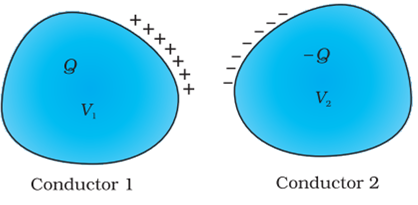Capacitors and Capacitance
A capacitor is a system of two conductors separated by an insulator. The conductors have charges, say Q1 and Q2, and potentials V1 and V2.
The conductors may be so charged by connecting them to the two terminals of a battery. Q is called the charge of the capacitor, though this, in fact, is the charge on one of the conductors – the total charge of the capacitor is zero.
The electric field in the region between the conductors is proportional to the charge Q. That is, if the charge on the capacitor is, say doubled, the electric field will also be doubled at every point.
Potential difference V is the work done per unit positive charge in taking a small test charge from the conductor 2 to 1 against the field.

Consequently, V is also proportional to Q, and the ratio Q/V is a constant
The constant C is called the capacitance of the capacitor. C is independent of Q or V, as stated above. The capacitance C depends only on the geometrical configuration (shape, size, separation) of the system of two conductors.
The SI unit of capacitance is 1 farad (=1 coulomb volt-1) or 1 F = 1 CV–1.